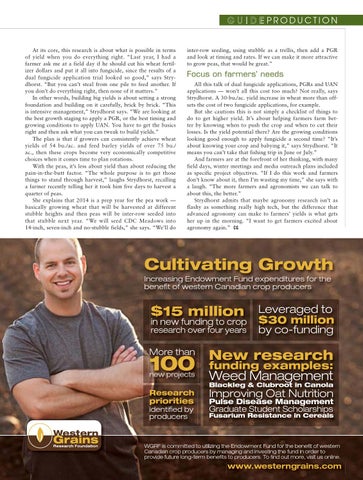PRODUCTION At its core, this research is about what is possible in terms of yield when you do everything right. “Last year, I had a farmer ask me at a field day if he should cut his wheat fertilizer dollars and put it all into fungicide, since the results of a dual fungicide application trial looked so good,” says Strydhorst. “But you can’t steal from one pile to feed another. If you don’t do everything right, then none of it matters.” In other words, building big yields is about setting a strong foundation and building on it carefully, brick by brick. “This is intensive management,” Strydhorst says. “We are looking at the best growth staging to apply a PGR, or the best timing and growing conditions to apply UAN. You have to get the basics right and then ask what you can tweak to build yields.” The plan is that if growers can consistently achieve wheat yields of 54 bu./ac. and feed barley yields of over 75 bu./ ac., then these crops become very economically competitive choices when it comes time to plan rotations. With the peas, it’s less about yield than about reducing the pain-in-the-butt factor. “The whole purpose is to get those things to stand through harvest,” laughs Strydhorst, recalling a farmer recently telling her it took him five days to harvest a quarter of peas. She explains that 2014 is a prep year for the pea work — basically growing wheat that will be harvested at different stubble heights and then peas will be inter-row seeded into that stubble next year. “We will seed CDC Meadows into 14-inch, seven-inch and no-stubble fields,” she says. “We’ll do
inter-row seeding, using stubble as a trellis, then add a PGR and look at timing and rates. If we can make it more attractive to grow peas, that would be great.”
Focus on farmers’ needs All this talk of dual fungicide applications, PGRs and UAN applications — won’t all this cost too much? Not really, says Strydhorst. A 30-bu./ac. yield increase in wheat more than offsets the cost of two fungicide applications, for example. But she cautions this is not simply a checklist of things to do to get higher yield. It’s about helping farmers farm better by knowing when to push the crop and when to cut their losses. Is the yield potential there? Are the growing conditions looking good enough to apply fungicide a second time? “It’s about knowing your crop and babying it,” says Strydhorst. “It means you can’t take that fishing trip in June or July.” And farmers are at the forefront of her thinking, with many field days, winter meetings and media outreach plans included as specific project objectives. “If I do this work and farmers don’t know about it, then I’m wasting my time,” she says with a laugh. “The more farmers and agronomists we can talk to about this, the better.” Strydhorst admits that maybe agronomy research isn’t as flashy as something really high tech, but the difference that advanced agronomy can make to farmers’ yields is what gets her up in the morning. “I want to get farmers excited about agronomy again.” CG
Cultivating Growth Increasing Endowment Fund expenditures for the benefit of western Canadian crop producers
$15 million
in new funding to crop research over four years
More than
100 new projects
Research
priorities identified by producers
Leveraged to $30 million by co-funding
New research funding examples:
Weed Management
Blackleg & Clubroot in Canola
Improving Oat Nutrition
Pulse Disease Management
Graduate Student Scholarships
Fusarium Resistance in Cereals
WGRF is committed to utilizing the Endowment Fund for the benefit of western Canadian crop producers by managing and investing the fund in order to provide future long-term benefits to producers. To find out more, visit us online.
www.westerngrains.com WGRF Endowment Fund Half-page Ad_final.indd 1
2013-09-12 8:34 AM
